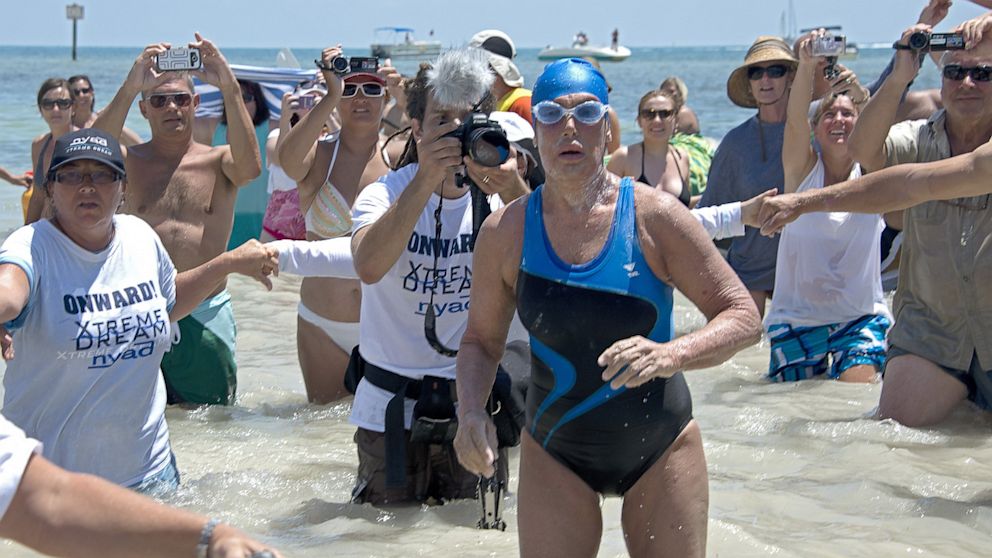
MIAMI (AP) — Diana Nyad on Tuesday defended her 110-mile swim from Cuba to Florida to skeptics who questioned whether she got into or held onto a boat during part of the journey.
Nyad said she swam without being propelled or held up by any of the boats or people accompanying her.
“I swam. We made it, our team, from the rocks of Cuba to the beach of Florida, in squeaky-clean, ethical fashion,” Nyad said.
Her critics have been skeptical about long stretches of the 53-hour swim were Nyad appeared to have either picked up incredible speed or to have gone without food or drink. Since Nyad finished her swim Sept. 2 in Key West, long-distance swimmers have been debating the topic on social media and in online forums.
Nyad’s speed, at some points more than doubling her average of 1.5 mph, has drawn particular scrutiny. Her team has attributed her speed to the fast-moving Gulf Stream flowing in her favor.
The 64-year-old endurance athlete and her team held a sometimes contentious conference call with some of those who questioned her navigator’s credentials and observations of the currents.
“Many of us are pursuing this as a technical matter,” said Richard Clifford, a New York attorney and a kayaker for open water swimmers. “Having the information out there helps us analyze it, measure it, test it, smell it, you know, decide if it looks right and is right, and you guys keep saying it is. So, let us look at it.”
Nyad’s navigator, John Bartlett, said her fastest speed averaged about 3.97 mph over a 5.5-hour period over about 19 miles, crossing the strongest parts of the Gulf Stream, which was flowing at a favorable angle.
“What you’re seeing is the combination of the speed of Diana propelling herself in the water and the speed of the current carrying us across the bottom,” he said.
Nyad pledged that all the observations and notes taken by Bartlett and two official observers of the swim will be made available.
Evan Morrison, co-founder of the online Marathon Swimmers Forum, says it will be interesting to compare those observations made with publically available data about the currents Nyad swam.
Nyad attempted the swim from Cuba to Florida four times before finally completing the journey on her fifth attempt, making her the first to make it without the aid of a shark cage.
She did follow a streamer dangled in the water by her team and used a specialized mask and bodysuit to protect herself from venomous jellyfish, which are considered a more serious threat than sharks in those waters. There are some members of the marathon swimming community who say these methods violated the traditions of her sport.
Nyad said she supported applying to the Florida Straits the generally accepted marathon swimming guidelines prohibiting athletes from holding onto their support boats or using equipment such as flippers, but she maintained that the protective suit was the only way to survive the jellyfish. She said she was open to sharing her innovations with future swimmers.
“I don’t mean to fly in the face of your rules, but for my own life’s safety, a literal life-and-death measure, that’s the way we did it,” she said.
Not all of the open water swimmers questioned Nyad’s methods or track.
“I feel sorry for the questions you were just asked, understanding that when you’re the first person to do something, the questions you’re asked are rather ridiculous,” said Penny Dean, who set records swimming across the English and Catalina channels. “I think the only thing she needs to show are the logs of the swim.”
Nyad and her team said published statements by her doctors that she went seven hours without eating or drinking were mistakes, and while there were hours when she didn’t eat solid food, she never went more than 45 minutes without water.
Nyad she had not known about all the controversy over her methods and speed until it made national news.
“First of all, I was trying to feel some joy,” she said.
